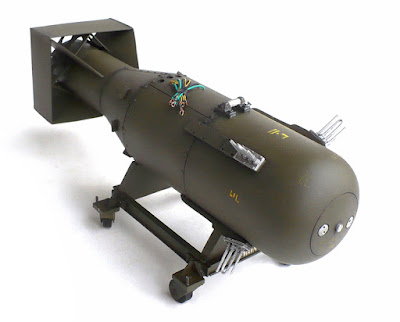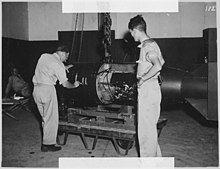During my researches I discovered that there were signatures on the original Little Boy bomb. Looking at the photographs it was difficult to make out these signatures. There was however one signature that stood out. That signature appears to be "R. Savior". But I could be wrong.
From Wikipedia"
"Little Boy" was the codename for the type of atomic bomb dropped on the Japanese city of Hiroshima on 6 August 1945 during World War II by the Boeing B-29 Superfortress Enola Gay, piloted by Colonel Paul W. Tibbets, Jr., commander of the 509th Composite Group of the United States Army Air Forces. It was the first atomic bomb to be used in warfare. The Hiroshima bombing was the second artificial nuclear explosion in history, after the Trinity test, and the first uranium-based detonation. It exploded with an energy of approximately 15 kilotons of TNT (63 TJ). The bomb caused significant destruction to the city of Hiroshima.
Little Boy was developed by Lieutenant Commander Francis Birch's group of Captain William S. Parsons's Ordnance (O) Division at the Manhattan Project's Los Alamos Laboratory during World War II. Parsons flew on the Hiroshima mission as weaponeer. The Little Boy was a development of the unsuccessful Thin Man nuclear bomb. Like Thin Man, it was a gun-type fission weapon, but derived its explosive power from the nuclear fission of uranium-235. This was accomplished by shooting a hollow cylinder of enriched uranium (the "bullet") onto a solid cylinder of the same material (the "target") by means of a charge of nitrocellulose propellant powder. It contained 64 kg (141 lb) of enriched uranium, of which less than a kilogram underwent nuclear fission. Its components were fabricated at three different plants so that no one would have a copy of the complete design.
After the war ended, it was not expected that the inefficient Little Boy design would ever again be required, and many plans and diagrams were destroyed, but by mid-1946 the Hanford Site reactors were suffering badly from the Wigner effect, so six Little Boy assemblies were produced at Sandia Base. The Navy Bureau of Ordnance built another 25 Little Boy assemblies in 1947 for use by the Lockheed P2V Neptune nuclear strike aircraft (which could be launched from but not land on the Midway-class aircraft carriers). All the Little Boy units were withdrawn from service by the end of January 1951.
The names for all three atomic bomb design projects during World War II—Fat Man, Thin Man, and Little Boy—were created by Robert Serber, a former student of Los Alamos Laboratory director Robert Oppenheimer who worked on the Manhattan Project. According to Serber, he chose them based on their design shapes. The "Thin Man" was a long device, and its name came from the Dashiell Hammett detective novel and series of movies of the same name. The "Fat Man" was round and fat, and was named after Sydney Greenstreet's "Kasper Gutman" character in The Maltese Falcon. Little Boy came last, and was named after Elisha Cook, Jr.'s character in the same film, as referred to by Humphrey Bogart.
Because uranium-235 was known to be fissionable, it was the first approach to bomb development pursued. As the first design developed (as well as the first deployed for combat), it is sometimes known as the Mark I. The vast majority of the work came in the form of the isotope enrichment of the uranium necessary for the weapon, since uranium-235 makes up only 1 part in 140 of natural uranium. Enrichment was performed at Oak Ridge, Tennessee, where the electromagnetic separation plant, known as Y-12, became fully operational in March 1944. The first shipments of highly enriched uranium were sent to the Los Alamos Laboratory in June 1944.
Most of the uranium necessary for the production of the bomb came from the Shinkolobwe mine and was made available thanks to the foresight of the CEO of the High Katanga Mining Union, Edgar Sengier, who had 1,000 long tons (1,000 t) of uranium ore transported to a New York warehouse in 1939.[6] At least part of the 1,200 long tons (1,200 t) of uranium ore and uranium oxide captured by the Alsos Mission in 1944 and 1945 was used in the bomb.
As part of Project Alberta, Commander A. Francis Birch (left) assembles the bomb while physicist Norman Ramsey watches. This is one of the rare photos where the inside of the bomb can be seen.
In July 1944, almost all research at Los Alamos was redirected to the implosion-type plutonium weapon. Overall responsibility for the uranium gun-type weapon was assigned to Captain William S. Parsons's Ordnance (O) Division. All the design, development, and technical work at Los Alamos was consolidated under Lieutenant Commander Francis Birch's group.
In contrast to the plutonium implosion-type nuclear weapon and the plutonium gun-type fission weapon, the uranium gun-type weapon was straightforward if not trivial to design. The concept was pursued so that in case of a failure to develop a plutonium bomb, it would still be possible to use the gun principle. The gun-type design henceforth had to work with enriched uranium only, and this allowed the Thin Man design to be greatly simplified. A high-velocity gun was no longer required, and a simpler weapon could be substituted. The simplified weapon was short enough to fit into a B-29 bomb bay.
The design specifications were completed in February 1945, and contracts were let to build the components. Three different plants were used so that no one would have a copy of the complete design. The gun and breech were made by the Naval Gun Factory in Washington, D.C.; the target case and some other components were by the Naval Ordnance Plant in Center Line, Michigan; and the tail fairing and mounting brackets by the Expert Tool and Die Company in Detroit, Michigan. The bomb, except for the uranium payload, was ready at the beginning of May 1945. The uranium 235 projectile was completed on 15 June, and the target on 24 July. The target and bomb pre-assemblies (partly assembled bombs without the fissile components) left Hunters Point Naval Shipyard, California, on 16 July aboard the heavy cruiser USS Indianapolis, arriving 26 July. The target inserts followed by air on 30 July.
Although all of its components had been tested, no full test of a gun-type nuclear weapon occurred before the Little Boy was dropped over Hiroshima. The only test explosion of a nuclear weapon concept had been of an implosion-type device employing plutonium as its fissile material, and took place on 16 July 1945 at the Trinity nuclear test. There were several reasons for not testing a Little Boy type of device. Primarily, there was little uranium-235 as compared with the relatively large amount of plutonium which, it was expected, could be produced by the Hanford Site reactors. Additionally, the weapon design was simple enough that it was only deemed necessary to do laboratory tests with the gun-type assembly. Unlike the implosion design, which required sophisticated coordination of shaped explosive charges, the gun-type design was considered almost certain to work.
The danger of accidental detonation made safety a concern. Little Boy incorporated basic safety mechanisms, but an accidental detonation could still occur. Tests were conducted to see whether a crash could drive the hollow "bullet" onto the "target" cylinder resulting in a massive release of radiation, or possibly nuclear detonation. These showed that this required an impact of 500 times that of gravity, which made it highly unlikely. There was still concern that a crash and a fire could trigger the explosives. If immersed in water, the uranium halves were subject to a neutron moderator effect. While this would not have caused an explosion, it could have created widespread radioactive contamination. For this reason, pilots were advised to crash on land rather than at sea.
The Little Boy was 120 inches (300 cm) in length, 28 inches (71 cm) in diameter and weighed approximately 9,700 pounds (4,400 kg). The design used the gun method to explosively force a hollow sub-critical mass of uranium-235 and a solid target cylinder together into a super-critical mass, initiating a nuclear chain reaction. This was accomplished by shooting one piece of the uranium onto the other by means of four cylindrical silk bags of cordite. The bomb contained 64 kg (141 lb) of enriched uranium. Most was enriched to 89% but some was only 50% uranium-235, for an average enrichment of 80%. Less than a kilogram of uranium underwent nuclear fission, and of this mass only 0.6 g (0.021 oz) was transformed into several forms of energy, mostly kinetic energy, but also heat and radiation.
The Little Boy pre-assemblies were designated L-1, L-2, L-3, L-4, L-5, L-6, L-7, and L-11. L-1, L-2, L-5, and L-6 were expended in test drops. The first drop test was conducted with L-1 on 23 July 1945. It was dropped over the sea near Tinian in order to test the radar altimeter by the B-29 later known as Big Stink, piloted by Colonel Paul W. Tibbets, the commander of the 509th Composite Group. Two more drop tests over the sea were made on 24 and 25 July, using the L-2 and L-5 units in order to test all components. Tibbets was the pilot for both missions, but this time the bomber used was the one subsequently known as Jabit. L-6 was used as a dress rehearsal on 29 July. The B-29 Next Objective, piloted by Major Charles W. Sweeney, flew to Iwo Jima, where emergency procedures for loading the bomb onto a standby aircraft were practiced. This rehearsal was repeated on 31 July, but this time L-6 was reloaded onto a different B-29, Enola Gay, piloted by Tibbets, and the bomb was test dropped near Tinian. L-11 was the assembly used for the Hiroshima bomb.
When the war ended, it was not expected that the inefficient Little Boy design would ever again be required, and many plans and diagrams were destroyed. However, by mid-1946 the Hanford Site reactors were suffering badly from the Wigner effect. Faced with the prospect of no more plutonium for new cores and no more polonium for the initiators for the cores that had already been produced, Groves ordered that a number of Little Boys be prepared as an interim measure until a cure could be found. No Little Boy assemblies were available, and no comprehensive set of diagrams of the Little Boy could be found, although there were drawings of the various components, and stocks of spare parts.
One of five casings built for the Little Boy bomb used on Hiroshima on display at the Imperial War Museum in London during 2015
The Navy Bureau of Ordnance built 25 Little Boy assemblies in 1947 for use by the nuclear-capable Lockheed P2V Neptune aircraft carrier aircraft (which could be launched from but not land on the Midway-class aircraft carriers). Components were produced by the Naval Ordnance Plants in Pocatello, Idaho, and Louisville, Kentucky. Enough fissionable material was available by 1948 to build ten projectiles and targets, although there were only enough initiators for six. All the Little Boy units were withdrawn from service by the end of January 1951.
The Smithsonian Institution displays a Little Boy; it was complete, except for enriched uranium, until 1986. The Department of Energy took the weapon from the museum to remove its inner components, so the bombs could not be stolen and detonated with fissile material. The government returned the emptied casing to the Smithsonian in 1993. Three other disarmed bombs are on display in the United States; another is at the Imperial War Museum in London.










2 comments:
Very nice build.
Do you know this kit in 1/10th scale ? https://youtu.be/CvOQ6-vtcvQ
Hi Atom - No I haven't. It looks to be judging from the video to be one fantastic kit though. Easily more involved than this one. Thanks for sharing.
Post a Comment